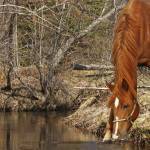Equine Monocytic Ehrlichiosis in Horses

Equine monocytic ehrlichiosis (EME) is a disease that causes clinical signs of fever, inappetence, and diarrhea. Laminitis occurs in 25-40% of affected horses and some strains can cause abortion. Neorickettsia risticii is an ehrlichial bacteria and infects monocytes (a type of white blood cell). The common name Potomac horse fever originated from the area where EME was first recognized along the Potomac River in the eastern United States. Cases of EME tend to occur during late summer or fall.
The causative bacteria are carried by trematode flukes that parasitize freshwater snails. Horses become infected when they drink water inhabited by infected flukes or snails. In recent years, it was recognized that several insects whose lifecycles involve water can also become carriers of EME. It is believed that these insects are important for the transmission of EME when horses do not have access to natural water sources. Insects are often attracted to lights and can become entrapped in horses’ water buckets and then infect them with EME. It is important to design barns and paddocks so that lighting and water sources are not in the same immediate area. Horses affected with EME cannot infect other horses.
The diagnosis of EME is made using polymerase chain reaction (PCR) techniques, which detect N. risticii organisms in the horse’s blood or feces. There are also some antibody tests that can aid in the diagnosis, but these are affected by recent vaccination status and can be difficult to interpret. Routine blood work usually shows low white blood cell count and dehydration.
Tetracycline antibiotics are very effective against EME, especially if started early in the course of the disease. Treatment of diarrhea is symptomatic and includes intravenous fluids and anti-inflammatories. Laminitis can be catastrophic and must be continually monitored and treated aggressively. Horses that respond favorably generally improve soon after the administration of tetracycline.
Several vaccines are available against EME, though with variable success. The vaccine is produced from one isolated strain of N. risticii, but there are several different strains in nature, which limits its effectiveness. Consult with your veterinarian for vaccinations recommendations in your area. Owners who live in areas where EME occurs should be vigilant for any signs of inappetence or diarrhea in their horses during the late summer and fall, so that appropriate diagnostics and treatment can be performed as soon as possible to give the best chance for a successful outcome.








